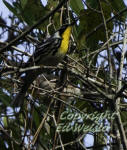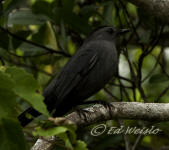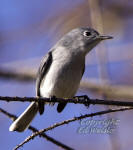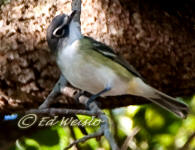Birds of Florida
Woodpeckers and Passerine
Pileated Woodpecker, Red-bellied Woodpecker, Downy Woodpecker, Yellow-bellied Sapsucker, Red-Winged Blackbird, Yellow-throated Warbler, Northern Mockingbird, Gray Catbird, Blue-Gray Gnatcatcher, Blue-Headed Vireo
Pileated Woodpecker - Dryocopus pileatus
Family - Picidae


Average length - 18 inches with a wingspan of 29 inches. Makes large excavations in trees to find ants and beetle larvae, its two main food sources.
Pilated Woodpeckers are black with a red, pointed crest, thin neck & white and black stripes on the face and sides of the birds neck. Males have red foreheads and "moustache", females have a black forehead and "moustache". Prefers mature forest habitat with large trees. Nests in tree cavities.
Red-bellied Woodpecker - Melanerpes carolinus
Family - Picidae
2_small.jpg)

Body is 9-10 inches, a small round headed woodpecker, very common throughout Florida. Black & white barred wings and back, face and underside are creamy white to pale gray with a pale red patch on the belly.
Males forehead, crown and hindneck are red, the females crown is gray.
The Red-bellied Woodpecker prefers mature forest habitat and feed on acorns, seeds, fruit and insects. The male and female stay together only long enough to share in the excavation of a nesting cavity in a dead tree and care for the young, up to 10 weeks after they fledge.
Downy Woodpecker - Picoides pubescens
Family - Picidae


The Downy woodpecker is very similar to the Hairy woodpecker, also a Florida native. The Downy has a shorter body at 6 1/2 inches, than the Hairy woodpecker at about 9 inches. The Downy woodpecker has a bill half the size of it's head, while the Hairy woodpecker has a longer bill approximately the size of it's head (front to back).
Downy woodpeckers have a black forehead and crown, males have a red spot on their nape, juveniles have a red crown. Adult females lack any red.
Wings are black with white spots, tail is black, outer tail feathers are white with black spots, has a white stripe on its back.
The Downy woodpecker can been found in open woodlands and will visit bird feeders, preferring suet. Diet consists of insects, seeds and berries.
Yellow-bellied Sapsucker - Sphyrapicus varius
Family - Picidae


Yes, there really is a bird named the Yellow-bellied Sapsucker! This small woodpecker winters in Florida and it does make holes in trees to lick up the sap, its diet includes insects as well.
Yellow-bellied Sapsuckers are nine inches long, have a 16 inch wingspan, white stripe down the side, females usually have a red crown (it may be black), males have a red nape and crown, both sexes have pale yellow undersides.
Many other sap loving birds, small animals and insects use the holes the sapsucker chisels out, the Ruby-throated Hummingbird is able to extend its northern range because of the Yellow-bellied Sapsuckers efforts, it returns in spring after the sapsuckers have had a chance to drill enough holes for it to supplement its diet when flowers are scarce.
Red-winged Blackbird - Agelaius phoeniceus
Family - Icteridae


The male Red-winged Blackbird with his solid black, glossy feathers and bright red and yellow shoulder patches is usually perched in a conspicuous location singing his heart out.
The female spends most of her time hunting for insects or building intricate, suspended nests in the dense vegetation of marshes and shorelines of ponds, creeks and rivers. With a more subdued coloration than the males, the females are mottled brown with an whitish eyebrow.
Yellow-throated Warbler - Dendroica dominica
Family - Parulidae


Usually found high in the tree canopy feeding on insects, the Yellow-throated Warbler is a year round resident in the northern half of Florida and winters in S. Florida, this small (4 1/2 inch) songbird has a black forehead, eye stripe, and cheek, the cheek marking extends down the side. Grey upper side and white underside with black streaks on the side, white supercilium, a bright yellow breast and throat, and two white wing bars. Both sexes and juvenile are very similarly marked.
Northern Mockingbird - Mimus polyglottos
Family - Mimidae


The Northern Mockingbird was designated as the official Florida state bird in 1927.
Average size is 10 inches with a wingspan of about 14 inches. The Mockingbird is gray on its head and top side, a paler whitish-gray underneath, a dark tail with white outer tail feathers, white wing bars and wing patch. Mockingbirds are omnivorous, their diet consists of insects, fruit and seeds.
Courtship and breeding occurs from early spring though summer, Mockingbirds usually build their cup shaped nests 1-3 meters from the ground and produce 2-4 broods per year, they aggressively defend their territory.
Singing both day and night this aptly named bird may mimic the songs of more than 30 different birds, as well as barking dogs or mechanically produced noises such as car alarms and telephones ringing!
Gray Catbird - Dumetella carolinensis
Family - Mimidae

Gray Catbirds are slightly smaller than the Northern Mockingbird and are found year round in N. Florida and as winter residents throughout the state, feeding on the berries and fruit of Holly, Greenbriar, Elderberry and other native trees and shrubs. Spring though fall diet is mainly insects.
These birds are usually found in dense thickets and tangled vegetation, avoiding open areas, they fly low over shrubs, flitting from place to place.
Related to the Mockingbird, the Gray catbird also mimics the songs of other birds while it has its own meow-like call for which it is named. Coloration is an overall gray with a black cap and a rusty brown under the tail.
Blue-Gray Gnatcatcher - Polioptila caerulea
Family - Polioptilidae


The Blue-grey gnatcatcher is a small, active bird that doesn't sit still for long. They are always flitting from branch to branch in search of small insects, they also have a seeming nervous habit of constantly twitching their tails from side to side, actually it's done to scare up insects.
Blue-grey gnatcatchers are 4 1/2 inches long with a thin bill, white eye ring and are blue grey on their upper parts, white under parts and a long black tail with white outer feathers.
Blue-Headed Vireo - Vireo solitarius
Family - Vireonidae


A winter resident of Florida, the Blue-Headed Vireo goes about its business of gleaning insects from leaves and branches in a deliberate manner, carefully picking its way through the tree canopy.
Also known as a "Solitary Vireo", this, the easternmost form plus a mid-west and western form (Cassin's Vireo and Plumbeous Vireo) were once considered a single species.
The adult Blue-Headed Vireo is 5 to 6 inches long with a 7 to 9 1/2 inch wingspan, head and topside is blue-gray, white spectacles, wings have two white bars, flanks are dull yellow. Immature birds are similar to adults but are have more drab colors. Migrates to extreme N.E. United States and Canada for the summer/breeding season.